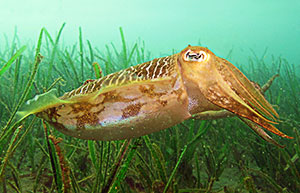Great Barrier Reef Plants Grasses, Algae, Mangroves of the Great Barrier Reef?

Photo: Cuttlefish swimming over seagrass
The Great Barrier Reef, located off the north-eastern coast of Australia, is home to a variety of vegetation. The most prevalent type of plants is sea grasses. It also contained various types of algae such as seaweed, which are not true plants at all. Mangroves, which are actually terrestrial plants that grow above the surface of the sea but have their roots in it, are also considered part of the Great Barrier Reef flora. This reef flora captures atmospheric carbon five times faster than tropical forests.
Sea Grasses
Photo: Diagram of seagrass structure
Fifteen species of seagrasses grow in the Great Barrier Reef. They are most often found in shallow and protected lagoons referred to as back reefs which are usually found between a coral reef and the shore.
Seagrasses are true plants (unlike seaweed and algae) with roots, flowers, and seeds. They grow in shallow water where sunlight can reach them. Using photosynthesis chloroplasts in their tissues convert carbon dioxide and water into sugar and oxygen which is transported throughout the plant by veins. Seagrasses lack stomata—the tiny pores on leaves that open and close to control water and gas exchange. Instead, they have a cuticle layer, which allows gasses and nutrients to diffuse directly in and out of the leaves from the water.
Similar to grasses on land, seagrass shoots are connected underground by a network of large root-like structures called rhizomes. Seagrass roots and rhizomes not only anchor the plant to the seafloor, they also absorb and store nutrients.
Photo: Turtle eating seagrass
Seagrasses may reproduce sexually or asexually. Since they are true flowering plants (angiosperms), male flowers release pollen into the water where they are moved by waves and ocean currents and encounter female flowers to pollinate. These flowers then develop seeds that, when released, can float many miles before settling onto the seafloor and germinating into new plants. Asexual reproduction takes place when the plants send out runners spread under the sediment and send up new shoots.
Seagrasses absorb carbon from the water to build their leaves and roots. It is estimated that they can sequester 83 g carbon per square metre per year. Phenomenally, one square meter of seagrass can generate up to 10 litres of oxygen a day through photosynthesis.
Vast seagrass meadows cover such huge areas that they are visible from space. They are home to a diverse community of organisms and an important food source for turtles, dugongs, fish, octopuses, squids, cuttlefish, snails, oysters, sponges, shrimps, sea fleas, worms, urchins, anemones, micro-algae, crabs, polychaetes, clams, diatoms, dinoflagellates, copepods and many other creatures.
Seaweed (Macro-algae)
Photo: Diagram of algae structure
Seaweeds are multicellular marine algae known as macroalgae with cells that have bonded together to create a plant-like structure. In general, seaweeds are divided into three groups based on their colour of green, brown and red. There are over 400 species of marine algae growing in the Great Barrier Reef. Red and brown algae are found closer to the shore while red and green algae are more prevalent in offshore areas.
Most species of seaweeds are made up of three distinct parts the holdfast, stipe, and blades. The holdfast is a footpad that attaches the seaweed to a surface such as dead coral or rock, and are generally not capable of absorbing nutrients. To the holdfast is attached a stipe or stem from which there may be one or more leaf-like blades. Some species have air-filled bladders in their blades that assist in holding the algae upright in the water. Seaweeds have no flowers or veins. Nutrients and gases are exchanged directly across the surface of the seaweed by diffusion.
Seaweeds use photosynthesis to convert carbon dioxide and essential minerals dissolved in the water into glucose and oxygen. Oxygen is a by-product of which dissolves in the water and is then eventually released into the atmosphere.
Photo: Fish swimming amongst algae
Seaweed reproduction can involve either exclusively sexual or asexual phases, while some species display an alternation of generations that involves both in succession. In sexual reproduction, the seaweed produces gametes (egg and sperm cells) with a single set of chromosomes. These float in the water and fertilisation takes place. In asexual reproduction, the seaweed produces spores containing both sets of chromosomes necessary to create an offspring. These drift away from the parent, establish themselves in new locations, and grow into individual organisms. Some species can also reproduce asexually by fragmentation where blades shed small pieces of material that develop into completely independent organisms.
Algae play an important role in the ecology of the reef. They are major reef formers and create habitats for numerous invertebrates and vertebrates. In addition, they are a major food source for a large variety of herbivores, fishes, crabs, sea urchins and zooplankton. They also leak organic carbon into the water which is consumed by bacteria who in turn are consumed by many filter feeders.
Mangroves
Photo: Mangrove trees
Mangroves are plants that grow along many parts of the coastline along the Great Barrier Reef. There are 39 species of these plants that cover an area of approximately 3800 km2 of coastline. These represent almost all of the mangroves species found in Australia and half all mangrove species in the world. Mangroves provide an important buffer between land and reef. They benefit the reef by stabilizing shorelines, improving water quality by filtering out land runoff and pollutants. The extensive prop root systems of mangroves provide nursery habitats and protection for many reef animals.
All Rights Reserved. (Last Updated: Mar 01, 2021)